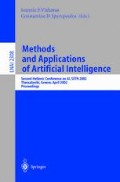Abstract
We present an integrated methodology for the discovery of hidden relations and underlying indicative patterns in time-series collections. The methodology is realized by the smooch integration of: (i) dynamic and qualitative discretization of time-series data, (ii) matching time-series by respective similarity assessment operations, and (iii) a novel hierarchical clustering process, grounded on a graph-theoretic technique, which combines information about the distances between objects and their respective featurebased descriptions. We apply our methodology on in-vivo neuropsychological data targeting the challenging task of patterning brain-developmental events.
Access this chapter
Tax calculation will be finalised at checkout
Purchases are for personal use only
Preview
Unable to display preview. Download preview PDF.
References
Agrawal, R., Lin, K., Sawhney, H.S., and Shim, K., Fast Similarity Search in the Presence of Noise, Scaling, and Translation in Time-Series Databases. Proc. 21st VLDB Conf. Zurich, Switzerland, 490–501 (1995).
Berndt, D. J., and Clifford, J. Using dynamic time warping to find patterns in time series. In Working Notes of the Knowledge Discovery in Databases Workshop, 359–370, (1994).
Bodeutsch, N., Siebert, H., Dermon, C.R., and Thanos S., Unilateral injury to the adult rat optic nerve causes multiple cellular responses in the contra lateral site. J. Neurobiol., 38, 116–128 (1998).
Box, G.E.P., and Jenkins, G.M. Time Series Analysis, Forecasting and Control. Prentice Hall (1976).
Cowan W.M., Adamson L. and Powell T.P.S., An experimental study of the avian visual system. J. Anatomy 95: 545–563 (1981).
Dermon, C.R., Deibler, G.E., Jehle, J., L. Sokoloff, and Smith, C.B., Local cerebral protein synthesis in the regenerating hypoglossal nucleus in euthyroid and hyperthyroid rats. Society for Neuroscience, 23th Annual Meeting. Washington, USA, abstr. 543.3, 1314 (1993).
Dermon C.R., Stamatakis A., Tlemcani O., and Balthazart, J., Performance of appetitive or consummatory components of male sexual behavior is mediated by different brain areas: A 2-deoxyglucose autoradiographic study. Neuroscience, 94, 1261–1277 (1999).
Faloutsos, C., Ranganathan, M., and Manolopoulos, Y., Fast Sequence Matching in Time-Series Databases. Proc. SIGMOD’94 (1994).
Fisher, D. Knowledge Acquisition Via Incremental Conceptual Clustering. Machine Learning, 2, 139–172. (1987).
Jacobson, S. Histogenesis and morphogenesis of cortical structures in the developmental neurobiology. Plenum Press., 401–451 (1991).
Jagadish, H., Mendelzon, A., and Milo, T., Similarity-Based Queries. Proc. 14th Symp. on Principles of Database Systems (PODS’95). 36–45 (1995).
Laird, P., Identifying and using patterns in sequential data. In: Jantke, K., Kobayashi, S., Tomita, E., and Yokomori, T. (Eds), Algorithmic Learning Theory, 4 th International Workshop, Berlin: Springer Verlag, 1–18, (1993).
Lopez, L.M., Ruiz I.F., Bueno, R.M., and Ruiz, F.T. Dynamic Discretization of Continuous Values from Time Series. In Ramon Lopez de Mantaras and Enric Plaza (eds) Proceedings of the 11 th European Conference on Machine Learning (ECML 2000), Catalonia, Spain, 280–291, May/June 2000.
Morik K., The Representation Race — Pre-processing for Handling Time Phenomena. Proc. European Conference on Machine Learning (ECML). Springer Verlag (2000).
Potamias, G, and Dermon, C. Patterning Brain Developmental Events via the Discovery of Time-Series Coherences. In G. Papadourakis (Ed.), Proceedings of 4 th International Conference on Neural Networks and Expert Systems in Medicine and Healthcare, 281–287, June 20–22, 2001, Milos, Greece, (2001).
Sokoloff L. and Smith B.B., Basic principles underlying radioisotopic methods for assay of biomedical processes in vivo, in Tracer Kinetics and Physiologic Modeling Eds. Lambrecht r.M. and Reseigno A., Springer-Verlag pp. 202–234 (1983).
Stamatakis A., Balthazart, J., and Dermon, C.R. Sex differences in local cerebral protein synthesis activity in quail as revealed by the in vivo autoradiographic 14C-leucine method. It. J. Anat. Embryol, 101, 207–210 (1996).
Zahn, C.T. Graph-Theoretical Methods for Detecting and Describing Gestalt Clusters. IEEE Transactions on Computers, 20, 68–86, (1971).
Wang, J., Chrin, G.-W., Marr, T., Shapiro, B, Shasha, D., and Zhang, K. Combinatorial patterns discovery for scientific data: Some preliminary results. In: Snodgrass, R., and Winslett, M. (Eds), Proc. ACM SIGMOD Conference on Management of Data (SIGMOD’94), MI, USA, 115–125 (1994).
Author information
Authors and Affiliations
Editor information
Editors and Affiliations
Rights and permissions
Copyright information
© 2002 Springer-Verlag Berlin Heidelberg
About this paper
Cite this paper
Potamias, G. (2002). Distance and Feature-Based Clustering of Time Series: An Application on Neurophysiology. In: Vlahavas, I.P., Spyropoulos, C.D. (eds) Methods and Applications of Artificial Intelligence. SETN 2002. Lecture Notes in Computer Science(), vol 2308. Springer, Berlin, Heidelberg. https://doi.org/10.1007/3-540-46014-4_22
Download citation
DOI: https://doi.org/10.1007/3-540-46014-4_22
Published:
Publisher Name: Springer, Berlin, Heidelberg
Print ISBN: 978-3-540-43472-6
Online ISBN: 978-3-540-46014-5
eBook Packages: Springer Book Archive

